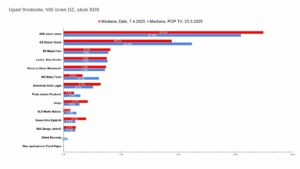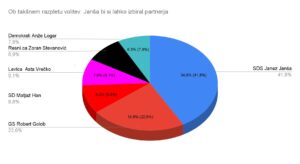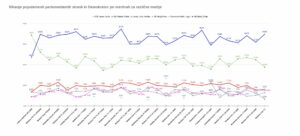By: Spletni časopis
If elections were held this Sunday, Janez Janša’s SDS would win by a huge margin, and after the elections, it would have numerous options to form a government with one of the smaller parties. Just one partner would be enough.
A poll published today by Mediana for Delo shows this scenario.
Polls should not be taken at face value – they also serve to shape public opinion and influence events.
The biggest shock in this poll is the result for Matej Tonin’s NSi, which would end up just outside parliament, far behind Anže Logar’s Democrats – at least according to Mediana’s measurement for Delo. Compared to a poll by the same agency for POP TV two weeks ago, SDS, which gathered 40,000 signatures for a referendum in the meantime, gained nearly four percentage points, while Robert Golob’s Svoboda lost almost the same amount.
With such an election outcome, the possibility of Golob securing another term would be nearly zero.

Tonin’s NSi had adopted a strategy after the last elections of declaring they would no longer join a government led by Janša, in an effort to boost their own significance. More recently, they even intensified the conflict. Judging by this latest poll, that strategy hasn’t paid off. Or perhaps the publication of these results is an attempt by the government side to create that impression. In any case, recent polls show NSi has failed to capitalise on its opposition role. In the last election, it placed third behind Svoboda and SDS. In recent months, it has fallen far from that standing.
These elections would also bring a significant shake-up for others, with two new parties entering parliament – Anže Logar’s Democrats and Zoran Stevanović’s Resni.ca – even though the “new faces” have not even emerged yet. Vesna, too, is hovering close to the threshold. Media sympathetic to the left are promoting Vladimir Prebilič as a potential new face from the left if Robert Golob can no longer maintain power. At the moment, he cannot.
If we recalculate the support by excluding parties that would not make it into parliament, the result of the election, according to Delo, would be:

Such a result would mean that Janez Janša and SDS would have wide open doors to form a government for the fourth time. The only possible alternative to an SDS-led government would be a coalition of all the other parties – a bloc of election losers so ideologically diverse that it would be even less cohesive than Marjan Šarec’s former minority government.
The Mediana poll for Delo also shows that SDS has succeeded in neutralising the threat that the Democrats might cut into their voter base. Even though Logar’s party would get 6.5 percent, SDS would reach 34.9 percent – one of its higher scores, even compared to when Logar was still a member. That is higher than Svoboda’s result in the last election. Meanwhile, Svoboda is now well below SDS’s 2022 election result.

Things are also unusual on the list of most popular politicians, which is usually dominated by left-wing figures and potential “new faces” from the left. At the very bottom are Zoran Janković, the would-be Serbian prime minister, and current PM Robert Golob. Compared to last month’s results, Urška Klakočar Zupančič suffered the biggest drop. The likely reason is the scandal involving Svoboda MP Miroslav Gregorič, who, while serving as an MP, was also managing his daughter’s company as a procurator. This further exposed Klakočar Zupančič’s hypocrisy during the push to change the law on the Constitutional Court, especially when the behaviour of Constitutional Court judge Klemen Jaklič was less questionable. The scandal involving rock guitarist and personal videographer Bor Zuljan, which the mainstream media could not fully cover up or downplay, also played a role.

In the graphs and the article in Spletni časopis, the parties’ support percentages are recalculated to include only voters who declared support for a specific party. This allows comparisons with past elections and among different surveys. “Declared” voters include those who picked an “other” party – usually ones not offered as options in the poll but named spontaneously by respondents. The original support levels from various polls, as published by media and used as the basis for recalculations, are presented in a table (clickable for enlarging):

All the data used as the basis for the recalculations are provided to make it easier to understand the differences between the surveys – and to enable verification in case of any errors in data transfer or processing.

